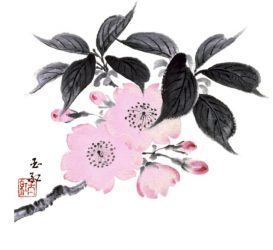History
The Senke School of Japanese Flower Arrangement was originated by Sen-no-Rikyu (1521-1591), who is perhaps best known as a master of the tea ceremony and an advisor to Toyotomi Hideyoshi. During the 18th century, Shotei, another great master of the Senke School, introduced changes in both style and containers. The principles laid down by Sen-no-Rikyu with improvements made by Shotei are still followed today.
In 1901, Mrs. Kane Shoji began the study of flower arrangement in her native Akita, Japan. Under the tutelage of Headmaster Shososai Yamada Okyo, she advanced from student, to instructor, to head instructor. In 1921, Kane Shoji came to the United States and in 1922 opened the Senke School of Japanese Flower Arrangement in Seattle. She taught the original styles and also developed and founded a new style called Senke-Shoji style moribana.
The Headmaster Shososai Yamada Okyo left instructions that upon his death, Kane Shoji was to succeed him. In 1939, she became Iyemoto or Headmaster of the Senke School of Japanese Flower Arrangement in Seattle and Japan. Today, Karen Nagai (I.I. Seattle Chapter 19 member), the great niece of Kane Shoji, is the Iemoto of the school.
Informal Styles
Nage-ire (“Thrown-in Style): Branches, vines and flowers are arranged informally to give an unstudied effect. Suitable containers can be made of ceramic, metal, fiber or wood.
Moribana Shiki Sai (Moribana Color Sryle): Flowers are arranged in a triangular pattern in a low bowl or basket. Senke Shoji style moribana typically combines together a variety of colorful flowers.
Moribana Shizen Shiki (Naturalistic Moribana): Flowers and woody materials are arranged in a manner suggestive of a natural scene, in a low shallow bowl. Designs represent mountain, garden, pond, or land with water settings.
Formal Style
Seikkwa (Seika, Formal or Classical): Materials are arranged following the orthodox principles of classical flower arrangement. Containers can be made of bamboo, bronze, or wood. Occasionally, certain styles of basket are used.
Source: Kane Shoji and Violet Johnson, The Japanese Principles of Flower Arrangement: Senke School. Chieftain Press, Seattle, 1950
Senke Teachers (Please click teacher names to expand)
Dean Ishiki
Class location(s): Seattle
About the teacher: Senke teaches the traditional styles of Ikebana – Moribana, Nageire and Seika. The class is organized more like a workshop rather than a formal course. Students are encouraged to come regularly but are welcome to come intermittently. Therefore, students progress at their own pace.
Contact: dmishiki@gmail.com

